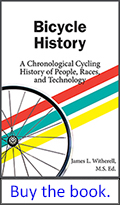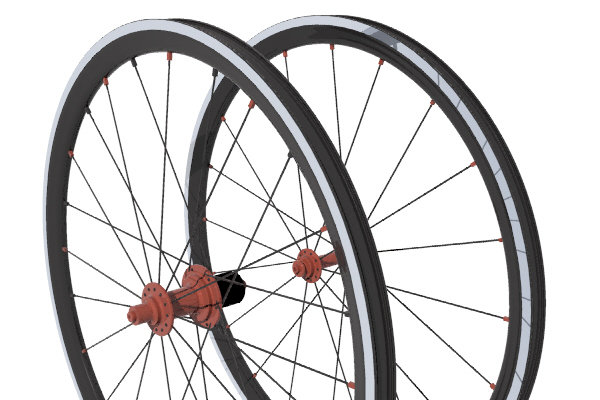

Buying New Wheels: What to Look For
by John Neugent
Tech articles | Commentary articles
The late John Neugent probably knew more about bicycle wheels than anyone else. Maybe more about bikes as well. He spent his life in the bike business, at every level. He owned Neugent Cycling, a firm devoted to delivering world-class equipment at the lowest possible price. —Chairman Bill

John Neugent

James Witherell's book Bicycle History: A Chronological History of People, Races and Technology is available in both print and Kindle eBook formats. Just click on the Amazon link on the right.
John Neugent writes:
For this article, I will limit the discussion to road bike wheels – and you can include cross and gravel in the same category. The most important issues are durability, weight, aerodynamics, performance, and appearance. How you ride has a big influence over your choices. Not only how fast, but how hard you are on wheels.
Wheels arguably take more abuse than any other part of the bike because they are the contact point with the road. Because they are a rotating mass, their quality, weight, aerodynamics, and other performance characteristics have a huge influence on ride quality and performance. They need to be both durable and high performance.
Some people are hard on wheels. Generally speaking, high tire pressures (along with small tires), hitting pot holes without un-weighting the bike, using big gears and high torques (instead of spinning) are traits of people who are hard on wheels. I know of people over 250 pounds who can ride very light wheels without problems and light people who destroy them.
Spoke count affects durability, weight, aerodynamics, performance, and appearance. In the old days, wheels with 36 spokes were common – even the norm. Then Mavic introduced wheel systems in the late '80s in which they sold not only the rim but also the complete wheel. This allowed them to reduce spoke count because they were making the hubs too. Spokes weigh anywhere between 4 to 9 grams. A common straight 14 gauge spoke weighs 6 grams. With a 20-spoke front wheel and a 24-spoke rear, the spokes weigh 264 grams – two 36-spoke wheels would be 432 grams or a 168 gram difference. But that’s just the beginning because the lower spoke count is much more aerodynamic (spokes are little egg beaters).
In the last thirty years spoke makers have engineered spokes to be both lighter and stronger. A 4 gram Sapim CX Ray spoke is stronger than their straight gauge 6-gram spoke. This is because the failure mode for spokes is fatigue and they have cold forged the lighter spoke to have more fatigue resistance.
Spokes are not only one of the most important components of a wheel, they are often cost more than either the hubs or rims.

Today's spokes are lighter and stronger than ever.
Wheel stiffness is primarily a function of rim profile and spoke count. As I have said many times, spoke tension does not affect wheel stiffness. But for that reason, most high end wheel companies choose not to use fewer than 24 spokes on the rear wheel. Less than that, even with carbon rims (which are extremely stiff) and there is too much flex in the rear wheel. Front wheels are under much less stress and 16 spokes or more hold up fine.
Spoke count is also critical because it’s the first failure point of most low spoke count wheels – it’s the first thing to wear out. In the old days, with 36 spokes and lower quality hubs, hub durability was more important, but modern hubs are almost all easily good for more than 10,000 miles (most without maintenance). And by failure point, it’s not the spoke as often as it is a rim crack – typically on the drive side of the rear wheel. It’s not a big job to replace a rim so the lower spoke count options can be considered with rim replacement as maintenance.
So, in my opinion, spoke count is one of the critical issues in selecting a quality wheel and most importantly the spoke count on the rear wheel. For most people, including the pros, 24 seems to be the sweet spot. People harder on wheels, should look for 28 or 32.
You can get by with fewer spokes if they are stronger and stiffer, and I did that for many years using a 13 gauge (2.3 mm) spokes but you are giving something up in rim durability.
What kind of spokes? There are steel, aluminum, carbon, and straight pull and normal J bend spokes. I prefer J bend steel spokes because they tend to be readily available everywhere in the world, are easy to replace and generally less expensive. Mavic was the first modern wheel company to introduce aluminum spokes and I don’t see anything wrong with them but I don’t understand what advantage they have over a normal steel spokes. The vast majority of the pros use steel spokes. Straight pull spokes solve a problem that no longer exists – spokes breaking at the bend. While this was normal 30 years ago it’s not now an issue. Carbon spokes normally have to be serviced at the factory – which to me is an issue since spokes are normally the first part of a wheel to fail.
Rims are also important – not only because of weight, but materials, profiles, and construction methods. Rim weight is more important than hub weight because it’s the perimeter of the wheel. The heavier the rim the harder it is to spin up to speed. Alloy road rims are made basically three ways. Pinned rims are the heaviest and least expensive so most quality wheels don’t use them. Sleeved and welded are the methods most quality rim makers use to join the rim. Alloy rims are extruded in straight bars and then rolled in a coil and finally sawed. The two mating surfaces of the rim at the joint are therefore from the extruded piece but a few feet apart in the piece. So there are virtually always a small difference in the exact shape where they meet. They are joined by either welding, or with an internal sleeve and glue. After they are joined, the braking surface is machined. Both welding and a sleeve are good but I prefer the sleeve because welding nearly always slightly warps the rim.
Aluminum alloys. Over the 20 years or so I have been building wheels, the alloys have continually gotten better. Many wheel companies trademark names for the alloys they use – which is a marketing strategy and fine, but in reality the amount of aluminum any wheel company uses is tiny in comparison to other industries and virtually all rim companies buy extruded pieces and roll them into rims taking advantage of the latest alloy technology.

Like nearly everything on bikes, alloy wheels have continually improved.
Carbon or alloy? More and more this is the question many people are asking. I have written another article for this site on this subject. But for a quick over view, for the most part carbon rims excel at being aerodynamic. Aerodynamics becomes more and more critical the faster you go.
http://www.bikeraceinfo.com/tech/alloy-or-carbon-wheels.html
Rim width: Over the last 10 years both rims and tires are getting wider. They offer many advantages and unlike most marketing claims, they are real. The standard road tire is now becoming a 25 mm instead of a 23 mm. I have already written an article on this site about it.
http://www.bikeraceinfo.com/tech/rims-wider.html

Rims are getting wider.
Just a note on trends and fads. The bike industry in general and the pros all are very much influenced by them. For years, thinner, lighter wheels and tires were the norm. One company famously advertised incredibly high pressure tires. Maybe the epitome of this in my life time was in the late '70s when Shimano introduced aero components. Their engineers did their homework and realized (correctly) that aerodynamics played a much more important part in performance than people thought. At this time Shimano had little credibility in quality components since their focus had been on low end components. It became the laughing stock of the industry until about 20 years later companies like Cervelo, HED, Zipp, and others successfully reintroduced the same concept.
Wheel building. A number of quality wheels are machine made. Why would a hand built wheel be better? Some are actually partially machine made – having people finish them off. Having a wheel hand built by a quality wheel builder does make a difference in durability. Machines can torque a spoke to a specific tension and true the wheel to a spec. There are two issues. Spoke nipple torque is a poor measurement of spoke tension. Spokes and nipples, even the best of them, are mass produced and it’s common to have spoke nipples needing different torques to get to the same spoke tension.
A human can adjust for this better than a machine. Just as critically, the strongest wheels are built with the fewest possible spoke nipple turns. Once a rim is under tension, every turn of the spoke nipple fatigues the spoke hole in the rim. Master builders completely true a wheel under virtually no tension and only then take the spokes up to the target tension with the fewest possible nipple turns under tension. There is no way to see this in a wheel, it’s built in.

Wheel building: There are some things people just do better than machines.
Hubs. When most people think of a wheel they see the hub as the key part. In the past it was true. Now, not so much. Hubs are basically a shell connecting the spokes to the bearings which ride on the axle. Rear hubs have the addition of a cassette body for the sprockets but that too is just a body on some bearings rolling on the axle (with the addition of pawls to engage the hub). In the '70s, a few high end hub makers in the US started using cartridge bearings. The cartridge bearing is a cup and cone and bearing in a unit that is pressed into the hub shell. Their advantages are the precision bearings; inexpensive, and usually dual sealed. Bicycle cartridge bearings are made in the millions for many different industries. The result is that the hub makers no longer need to be concerned about bearing tolerances – just the tolerances of the hub shell and axle, which are far easier to control. It is now possible to get very good quality hubs at very reasonable prices.
Hub weight is almost always a function of bearing weight (the steel balls are the heaviest part of the hub). The smaller the bearing the lighter the hub, but it comes at a price. Smaller bearings wear out faster. It’s not really that big a deal because they are easily replaceable but if you are looking for super light hubs that’s the price you will pay.
So which wheels should you buy? I have tried not to answer that question as much as give you reasons to choose one set over another. If I were racing, I would do my best to invest in a set of carbon wheels. If I were out on club rides where people are trying to drop each other (as in most group rides), I would do the same. If I were more a casual or sports rider who had more problems in the hills I would opt for a light set of alloy wheels.
Currently many people buy used components – which is fine. If I were buying a used set I would focus on a few things. Are they 11 speed compatible? More and more this is the new standard. If you don’t need it though, you can save some money.
Check the rim for spoke hole cracks – especially on the drive side rear. Spin the wheels in your fingers – if they feel smooth you are fine. If they are a little rough, it’s not hard to change most bearings out. Check the trueness of the wheels. They should appear straight. The most important factor here is radial trueness – not lateral. If I look at a wheel, 90% of more of my focus would be on radial trueness. If a rim is round, it’s good. If it’s not, it should be rebuilt.
Upgrading wheels is the best way to get better performance from your bike. Most stock bikes – even high end ones, come with subpar wheels because most people base their purchase decision on frame material and component group. Even though logic would tell you to use a lower end component group and better wheels, most people are confused (and rightfully so), so bike companies save money on wheels (along with saddles, bars, stems, tires, and a few other components). I once sold wheels to a very high end bike company and their comment was that their customers would already have their race wheels so they were looking for training wheels.
This does not address the other issues of tubular or clincher or tubeless versus tube wheels, which you will find here.
John Neugent was was one of the first to establish quality hand building in Taiwan around the turn of the century. He now owns Neugent Cycling, a firm devoted to delivering world-class equipment at the lowest possible price.







